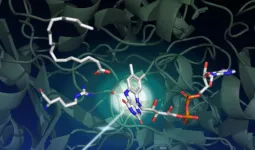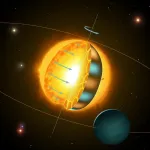(Press-News.org) Although many organisms capture and respond to sunlight, enzymes - proteins that catalyze biochemical reactions - are rarely driven by light. Scientists have identified only three types of natural photoenzymes so far. The newest one, discovered in 2017, is fatty acid photodecarboxylase (FAP). Derived from microscopic algae, it uses blue light to catalyze the conversion of fatty acids, found in fats and oils, into alkanes and alkenes.
"A growing number of labs envision using FAPs for green chemistry applications, because alkanes and alkenes are important components of solvents and fuels, including gasoline and jet fuels. And the transformation of fatty acids into alkanes or alkenes happens in a single step within the enzyme," says Martin Weik, the leader of a research group at the Institute of Biologie Structurale at the Universite Grenoble Alpes.
Weik is a primary investigator of a new study that has captured the complex sequence of structural changes FAP undergoes in response to light, called a photocycle, which drives this fatty acid transformation. Although researchers previously proposed a FAP photocycle, the fundamental mechanism was not understood. The scientists didn't know how long it took a fatty acid to lose its carboxylate, the chemical group attached to the end of its long chain of hydrocarbons, a critical step in forming alkenes or alkanes.
In collaboration with SLAC scientists, experiments at the Linac Coherent Light Source (LCLS) at the Department of Energy's SLAC National Accelerator Laboratory helped answer many of these outstanding questions. The researchers describe their results in Science.
All the tools in a toolbox
To understand a light-sensitive enzyme like FAP, scientists use many different techniques to study processes that take place over a broad range of time scales - because photon absorption happens in femtoseconds, or millionths of a billionth of a second, while biological responses on the molecular level often happen in thousandths of a second.
"Our international, interdisciplinary consortium, led by Frederic Beisson at the Universite Aix-Marseille, used a wealth of techniques, including spectroscopy, crystallography and computational approaches," Weik says. "It's the sum of these different results that enabled us to get a first glimpse of how this unique enzyme works as a function of time and in space."
The consortium first studied the complex steps of the catalytic process at their home labs using optical spectroscopy methods, which investigate the electronic and geometric structure of atoms in the samples, including chemical bonding and charge. Spectroscopic experiments identified the enzyme's intermediate states accompanying each step, measured their lifetimes and provided information on their chemical nature. These results motivated the need for the ultrafast capabilities of the LCLS.
Next, a structural view of the catalytic process was provided by serial femtosecond crystallography (SFX) with the LCLS X-ray free-electron laser (XFEL). During these experiments, a jet of tiny FAP microcrystals was hit with optical laser pulses to kick off the catalytic reaction, followed by extremely short, ultrabright X-ray pulses to measure the resulting changes in the enzyme's structure.
By integrating thousands of these measurements - acquired using various time delays between the optical and X-ray pulses - the researchers were able to follow structural changes in the enzyme over time. They also determined the structure of the enzyme's resting state by probing without the optical laser.
Surprisingly, the researchers found that in the resting state, the enzyme's light-sensing part, called the FAD cofactor, has a bent shape. "This cofactor acts like an antenna to capture photons. It absorbs blue light and initiates the catalytic process," Weik says. "We thought the starting point of the FAD cofactor was planar, so this bent configuration was unexpected."
The bent shape of the FAD cofactor was actually first discovered by X-ray crystallography at the European Synchrotron Radiation Facility, but the scientists suspected this bend was an artifact of radiation damage, a common problem for crystallographic data collected at synchrotron light sources. Only SFX experiments could confirm this unusual configuration because of their unique ability to capture structural information before damaging the sample, Weik says.
"These experiments were complemented by computations," he adds, "Without the high-level quantum calculations performed by Tatiana Domratcheva of Moscow State University, we wouldn't have understood our experimental results."
Next steps
Despite the improved understanding of FAP's photocycle, unanswered questions remain. For example, researchers know carbon dioxide is formed during a certain step of the catalytic process at a specific time and location, but they don't know its state as it leaves the enzyme.
"In future XFEL work, we want to identify the nature of the products and to take pictures of the process with a much smaller step size so as to resolve the process in much finer detail," says Weik. "This is important for fundamental research, but it can also help scientists modify the enzyme to do a task for a specific application."
INFORMATION:
Other researchers are already working towards concrete FAP applications, including a group that is designing an economic way to produce bio-alkane gases such as propane and butane.
The interdisciplinary consortium included researchers from the Institute of Structural Biology in Grenoble, Max Planck Institute for Medical Research in Heidelberg, CEA Cadarache, Ecole Polytechnique in Paris-Palaiseau, Integrative Biology of the Cell Institute in Paris-Saclay, Moscow State University, and the ESRF and SOLEIL synchrotrons in Grenoble and Paris-Saclay, respectively.
LCLS is a DOE Office of Science user facility. Major funding for this work came from the French National Research Agency (ANR).
Citation: Damien Sorigue et al., Science, 9 April 2021 (https://doi.org/10.1126/science.abd5687)
SLAC is a vibrant multiprogram laboratory that explores how the universe works at the biggest, smallest and fastest scales and invents powerful tools used by scientists around the globe. With research spanning particle physics, astrophysics and cosmology, materials, chemistry, bio- and energy sciences and scientific computing, we help solve real-world problems and advance the interests of the nation.
SLAC is operated by Stanford University for the U.S. Department of Energy's Office of Science. The Office of Science is the single largest supporter of basic research in the physical sciences in the United States and is working to address some of the most pressing challenges of our time. For more information, visit END
For reasons not yet clear, pregnant women infected with the virus that causes COVID-19 are more likely to experience preterm births, pre-eclampsia, and other neonatal problems than non-infected women.
A team of Yale scientists decided to investigate whether the virus could be affecting placental tissue of infected expectant mothers. Their analysis found that while evidence of the virus in the placenta is rare, the placenta in infected mothers tended to exhibit a much higher level of immune system activity than those of non-infected pregnant women, they report April 22 in the journal Med.
"The good news is the placenta is mounting a robust defense against an infection that is far distant, in lungs or nasal tissue," said Shelli Farhadian, assistant professor of internal ...
April 22, 2021--(BRONX, NY)--Researchers at Albert Einstein College of Medicine have designed an experimental drug that reversed key symptoms of Alzheimer's disease in mice. The drug works by reinvigorating a cellular cleaning mechanism that gets rid of unwanted proteins by digesting and recycling them. The study was published online today in the journal Cell.
"Discoveries in mice don't always translate to humans, especially in Alzheimer's disease," said co-study leader Ana Maria Cuervo, M.D., Ph.D., the Robert and Renée Belfer Chair for the Study of Neurodegenerative Diseases, professor of developmental and molecular biology, ...
Soldiers, athletes, and motorists could lead safer lives thanks to a new process that could lead to more efficient and re-useable protection from shock and impact, explosion, and vibration, according to a new study.
Pressurised insertion of aqueous solutions into water-repellent nanoporous materials, such as zeolites and metal-organic frameworks, could help to create high-performance energy absorbing systems.
An international research team experimented with hydrothermally stable zeolitic imidazolate frameworks (ZIFs) with a 'hydrophobic' cage-like molecular structure - finding that such systems are remarkably effective energy absorbers at realistic, high-rate loading conditions, ...
As politics grows increasingly polarized, a new global study finds people often exaggerate political differences and negative feelings of those on the opposite side of the political divide, and this misperception can be reduced by informing them of the other side's true feelings. The study replicates earlier research in the United States, finding the phenomenon to be generalizable across 25 countries.
The new study was led by Kai Ruggeri, PhD, assistant professor of health policy and management at Columbia University Mailman School of Public Health, and replicates a 2020 study by Jeffrey Lees and Mina Cikara at Harvard University, who were also co-authors of the new study. The new findings ...
Stars spin faster than expected as they age according to a new study led by scientists at the University of Birmingham which uses asteroseismology to shed new light on this emerging theory.
All stars, like the Sun, are born spinning. As they grow older, their spin slows down due to magnetic winds in a process called 'magnetic braking'. Research published in 2016 by scientists at Carnegie Observatories delivered the first hints that stars at a similar stage of life as the Sun were spinning faster than magnetic braking theories predicted. The results from this study were based on a method in which scientists pinpoint ...
What The Study Did: This case series reports the risk factors, incidence rate and features of acute ischemic stroke experienced by a group of male patients ages 50 years or younger in the convalescent stage of COVID-19.
Authors: Tian Ming Tu, M.R.C.P., of the National Neuroscience Institute in Singapore, is the corresponding author.
To access the embargoed study: Visit our For The Media website at this link https://media.jamanetwork.com/
(doi:10.1001/jamanetworkopen.2021.7498)
Editor's Note: The article includes conflict of interest disclosures. Please see the article for additional information, including other authors, ...
What The Study Did: This study assesses the association between COVID-19 and maternal and neonatal outcomes in pregnant women with COVID-19 diagnosis compared with pregnant women without COVID-19 diagnosis.
Authors: Aris T.Papageorghiou, M.D., of the University of Oxford in the United Kingdom, is the corresponding author.
To access the embargoed study: Visit our For The Media website at this link https://media.jamanetwork.com/
(doi:10.1001/jamapediatrics.2021.1050)
Editor's Note: The article includes conflict of interest and funding/support disclosures. Please see the article for additional information, including ...
What The Study Did: This cohort study examines viral dynamics and transmission of infection for NBA players, staff and vendors who had clinically recovered from SARS-CoV-2 infection but continued to have positive test results following discontinuation of isolation precautions.
Authors: Christina Mack, Ph.D., M.S.P.H., of IQVIA, Real World Solutions, in Durham, North Carolina, is the corresponding author.
To access the embargoed study: Visit our For The Media website at this link https://media.jamanetwork.com/
(doi:10.1001/jamainternmed.2021.2114)
Editor's ...
What The Study Did: This review of 125 U.S.-based clinical trials that investigated the management of hearing loss assessed representation in the trials by race/ethnicity and sex.
Authors: Carrie Nieman M.D., M.P.H., of the Johns Hopkins University Bloomberg School of Public Health in Baltimore, is the corresponding author.
To access the embargoed study: Visit our For The Media website at this link https://media.jamanetwork.com/
(doi:10.1001/jamaoto.2021.0550)
Editor's Note: The article includes conflicts of interest and funding/support disclosures. Please see the article for additional ...
What The Study Did: Claims data were used to look at opioid use among young people (ages 10 to 21) who had been prescribed opioids for the first time.
Authors: J. Deanna Wilson, M.D., M.P.H., of the University of Pittsburgh School of Medicine, is the corresponding author.
To access the embargoed study: Visit our For The Media website at this link https://media.jamanetwork.com/
(doi:10.1001/jamanetworkopen.2021.4552)
Editor's Note: The article includes conflicts of interest and funding/support disclosures. Please see the article for additional information, including other authors, author contributions and affiliations, conflict of interest and financial disclosures, and funding and support.
# ...


